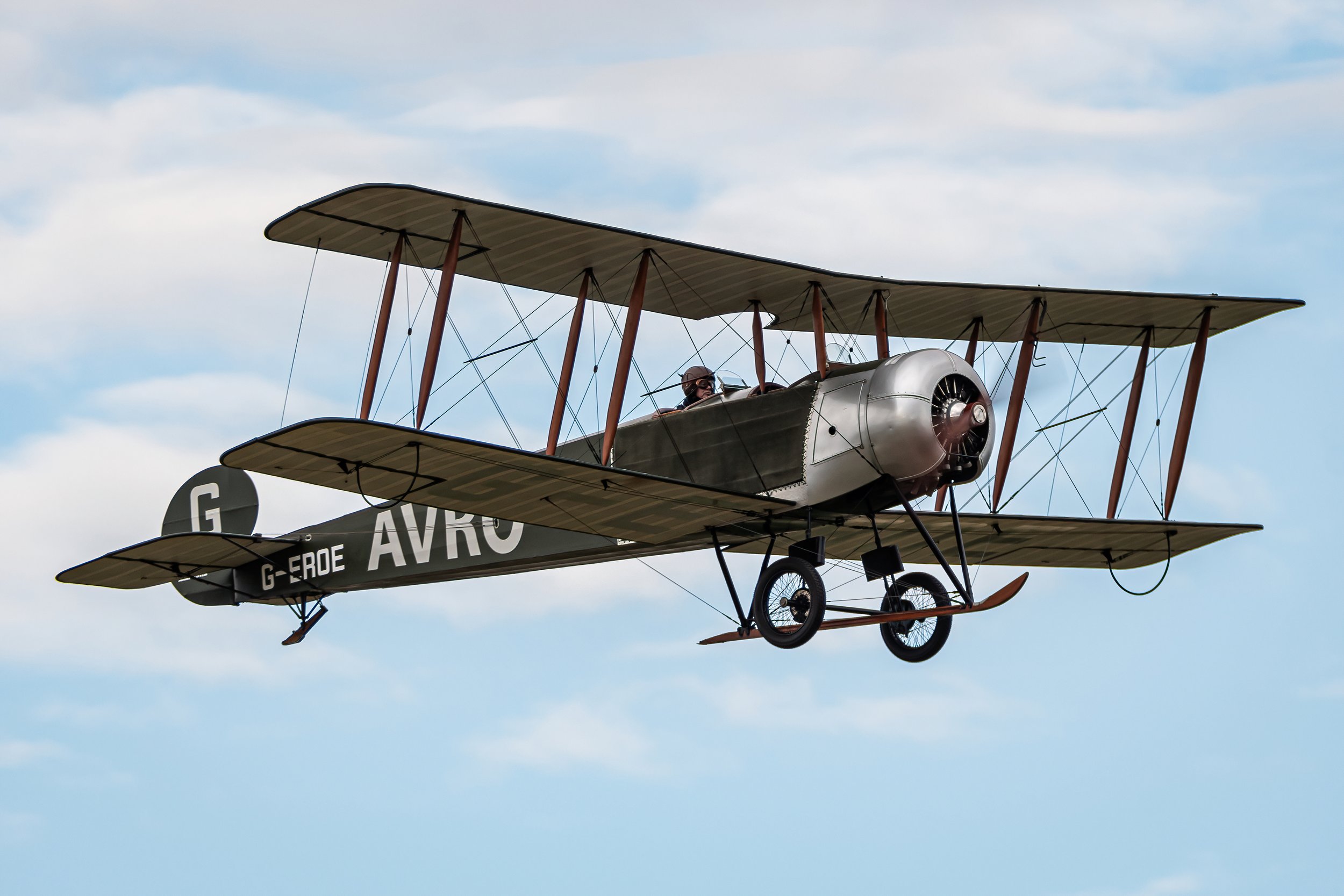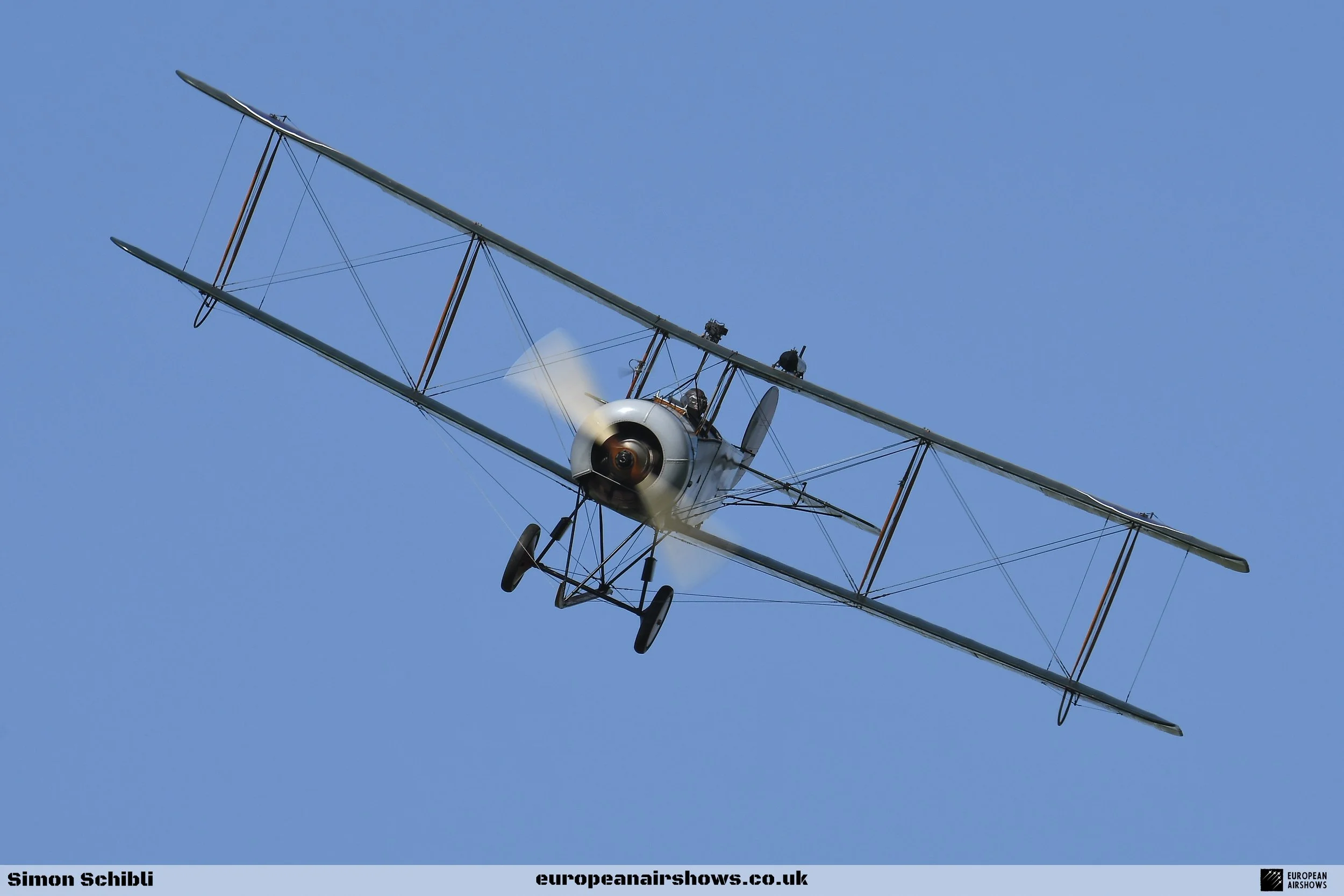
September 18 / Avro 504 first flight
First Flight 18 September 1913
Avro 504
The Avro 504, a quintessential British aircraft, holds a remarkable place in aviation history, primarily due to its extensive service during and after World War I. Designed and built by the A.V. Roe and Company, commonly known as Avro, this biplane first took to the skies in September 1913. Its creation was spearheaded by the company’s founder, Alliot Verdon Roe, and his team, who sought to produce a versatile and reliable aircraft that could serve multiple roles.
The Avro 504’s initial design featured a wooden structure covered in fabric, typical of the era’s aircraft construction. It was powered by a Gnome Lambda rotary engine, which produced around 80 horsepower. The aircraft’s configuration included a two-bay biplane arrangement with equal-span wings and a conventional tailplane. The cockpit was open, providing the pilot and observer with an unobstructed view, a crucial feature for both training and reconnaissance missions.
When World War I erupted in 1914, the Avro 504 quickly found its place in the Royal Flying Corps (RFC) and the Royal Naval Air Service (RNAS). Its early roles included reconnaissance, bombing, and even as a fighter in the initial stages of the conflict. One of its most notable early missions was the bombing raid on the Zeppelin sheds at Friedrichshafen on November 21, 1914, where three Avro 504s successfully damaged the German airship facilities. This mission demonstrated the aircraft’s capability to operate effectively in a combat role.
As the war progressed, the Avro 504’s primary role shifted towards training. Its forgiving flight characteristics, robustness, and ease of maintenance made it an ideal platform for training new pilots. The Avro 504K, a variant introduced in 1917, became the standard trainer for the RFC and later the Royal Air Force (RAF). This version featured a universal mounting that allowed it to accommodate various engines, making it easier to produce and maintain. Thousands of pilots earned their wings on the Avro 504K, cementing its legacy as a crucial training aircraft.
After the war, the Avro 504 continued to serve in various capacities. Surplus military aircraft were sold to civilian operators, who used them for a range of activities including barnstorming, joyriding, and air racing. The aircraft’s versatility also found it a role in civil aviation as a mail carrier and light transport. Additionally, several countries adopted the Avro 504 for their nascent air forces, further extending its operational life.
The interwar period saw the development of several variants of the Avro 504, each tailored to specific roles. The Avro 504N, for example, was an improved trainer with a more powerful engine and refined aerodynamics. The Avro 504Q was designed for gunnery training and featured a Lewis gun mounted on a ring in the rear cockpit. These variants ensured that the Avro 504 remained relevant and in service well into the 1930s.
The advent of World War II marked the end of the Avro 504’s operational military career, as more advanced aircraft took its place. However, its impact on aviation history remained indelible. The Avro 504 had trained thousands of pilots, contributed to early combat operations, and played a significant role in the development of both military and civil aviation.
In summary, the Avro 504’s history is a testament to its exceptional design and versatility. From its early days as a reconnaissance and bombing aircraft to its pivotal role as a trainer, the Avro 504 left an enduring legacy in the annals of aviation history. Its widespread use, adaptability, and the sheer number of pilots it trained underscore its importance and lasting influence on the development of aviation.
Avro 504 Facts
First Production Aircraft: The Avro 504 was one of the first aircraft to be mass-produced in Britain, with over 8,000 units built between 1913 and 1932. Its design and production helped establish Avro as a major player in the aviation industry.
Versatile Roles: Initially designed as a trainer, the Avro 504 was used in various roles, including reconnaissance, fighter, and bomber missions during World War I. Its versatility made it a popular choice for various military applications.
Multiple Variants: The Avro 504 was produced in several variants, including the 504A, 504K, and 504N, each with different engine configurations and modifications to meet specific operational needs.
Design Evolution: The aircraft’s design evolved over its production run, with improvements in performance, handling, and safety features. The 504K variant, for example, featured a more powerful engine and improved wings.
Training Aircraft: The Avro 504 became a standard trainer for the Royal Flying Corps (RFC) and the Royal Air Force (RAF) after the war. Its stable flying characteristics made it an ideal platform for training new pilots.
Uses: The Avro 504 was used for bombing missions, as a trainer for British pilots, and as an emergency fighter to defend against German aircraft raiders. One notable use was on November 21, 1914, when the RNAS used an Avro 504 to successfully bomb the Zeppelin Airship Sheds at Friederichshafen. After the war, surplus Avro 504Ks were used by civilian flying schools and barnstorming companies.
Post-War Use: After World War I, the Avro 504 continued to be used in various capacities, including civilian aviation and air racing. Many were adapted for agricultural use, such as crop dusting.
Cultural Impact: The Avro 504 has appeared in films and documentaries that depict early aviation and World War I, helping to preserve its legacy and significance in aviation history.
Surviving Examples: While many Avro 504s were retired or destroyed, a few examples have been preserved and are displayed in museums or flown at airshows, providing a glimpse into early aviation history.
Production: The Avro 504 was first flown in 1913 and production continued until 1932, with a total of more than 10,000 built. It was produced by Avro and at least 18 other contractors, making it the most-produced aircraft of any kind to serve in World War I.






